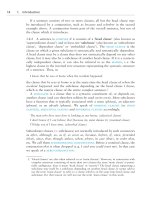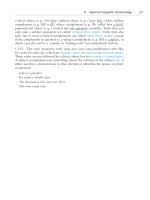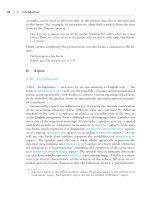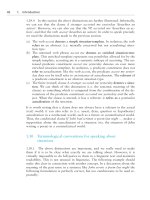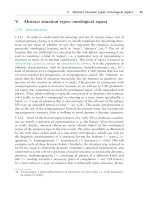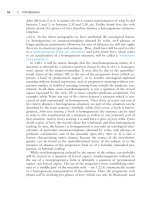The grammar of the english verb phrase part pdf
Bạn đang xem bản rút gọn của tài liệu. Xem và tải ngay bản đầy đủ của tài liệu tại đây (81.33 KB, 7 trang )
II. Uses of the absolute past tense 203
tion, a place adverbial may sometimes give only a very general idea of when
the situation actualized. All that is required is that the situation can be located
with sufficient precision for the purposes of the discourse. Thus I learned to
swim in Australia uttered when the hearer knows that the speaker was in
Australia between the ages of twenty and twenty-five is sufficiently precise to
convey the message ‘I was already an adult when I learned to swim’, and
this may be the main point that the speaker wishes to communicate by using
the adverbial.)
(b) There may be other constituents in the clause that are pragmatically linked
with a particular past time.
[“I haven’t got any cash left.”] Ϫ “I gave all mine to the milkman”. (Reference to
the milkman implies ‘this morning’ in the default case, assuming that the milkman
comes every morning.)
Did the ferry bring any visitors to the island? (implicit time: when the ferry came
to the island, as it does (e. g. around noon) every day)
(c) If there are no constituents in the sentence indicating or suggesting a spe-
cific past time, such a time may still be recoverable from the linguistic or
extralinguistic context.
Did you switch off the lights? (implicit time: when we left)
I couldn’t resist buying this book. (The hearer is expected to interpret the temporal
location as being the specific time when the speaker was in the bookshop. This time
does not have to be identifiable (definite) to the hearer; it needn’t be identifiable to
the speaker either, because the speaker may have forgotten the exact time when he
bought the book. All that is required is that the speaker and hearer take it as given
that there was an occasion of buying the book.)
In some cases past time reference is pragmatically inferrable from the immedi-
ate situation of speaking. Thus, if I see you with a broken leg, I can ask the
question How did you break your leg? The fact that you have broken it, hence
that there was a time when you broke it, is ‘given’ (assumed known) informa-
tion. It is therefore natural to use the past tense to ask for further information
about the incident.
(d) That the reference is to a particular past time may be clear from people’s
general pragmatic knowledge of the world. For example, we can use his-
torical events or shorthand references to historical events as a means of
providing an adequately precise location in time for a situation (and at the
same time often giving more information about the circumstances of the
situation). For example, we can say My ancestors arrived here with Wil-
liam the Conqueror or My family lost everything under Idi Amin.
4.6.4 In sum, for a temporal understanding of a clause in the past tense the
minimal requirement is that the hearer be aware of the existence of a specific
204 4. The absolute past tense
past time at which the situation actualized. For a full temporal interpretation
it is often necessary that that specific time should also be definite (identifiable)
to the hearer.
In most contexts, using a past tense without there being an identifiable time
of actualization is as inappropriate as using a (formally) definite noun phrase
without there being an identifiable referent. (Note that for a referent to be
‘identifiable’, i. e. for an NP to be definite, it is sufficient that the hearer be
familiar with, or be able to assume, the existence of the referent, even if the
mere use of the NP is not sufficient for the hearer to pick out the referent from
a given set, as in The police still don’t know who the murderer is, where the
murderer is an ‘attributive definite NP’ in the sense of Donnellan (1966).) The
necessity of there being a specific, preferably definite, past time at which the
situation time is located explains why the sentence John went for a stroll, when
uttered in isolation, automatically invites the question ‘when?’. The informa-
tion answering this question may be given by a specific (definite or indefinite)
time adverbial in the sentence itself (e. g. three days ago, a long time ago). If
there is no such adverbial, the necessary temporal information must be avail-
able from the linguistic or extralinguistic context in which the sentence is used
or from the pragmatic knowledge that is shared by the speaker and the hearer.
4.7 The past tense used for ‘actualization focus’
‘Actualization focus’ means that the speaker is only concerned with one of the aspects
of the bygone situation, such as why, where, how, etc. the situation actualized. In that
case he uses the past tense, not the present perfect. It should be noted, however, that
question words like why, where, etc. do not automatically entail actualization focus
and can therefore in some cases combine with the present perfect.
4.7.1 Sometimes the reason why the speaker uses the past tense (rather than
the present perfect) to describe a bygone situation is that he is only concerned
with one of the aspects of the bygone situation, such as why, where, how, etc.
the situation actualized, or who was involved in it. This idea of past actualiza-
tion focus
includes the concept of focus on a particular past time (THEN)
discussed in 4.6. In the present section we will concentrate on the other cases
in which actualization focus induces the use of the absolute past tense. The
following provide some typical examples:
[I have bought so many clocks in Switzerland that] I can’t remember which town I
bought that one in. (The speaker is only concerned with the question ‘where?’.)
II. Uses of the absolute past tense 205
[“Someone has sent me an anonymous letter.”] — “I think it was Lisa who sent it.”
(The speaker is only concerned with the question ‘Who sent it?’.)
Please tell me how you did it.
[I know he’s back.] What I’d like to know is
why he came back.
In cases like these there is actualization focus on the past: the speaker focuses
on some aspect of the past actualization of the situation (rather than on the
structure of the world at t
0
, as is the case when the present perfect is used.)
4.7.2 It is important to see that question words like why, where, etc. do not
automatically entail actualization focus. There are three cases in which they
are followed by the present perfect because the conditions for using the present
perfect are satisfied. The first is if there is a ‘continuative’ meaning (see 5.4.1)
to be expressed, as in Why have you been living in such a small house? The
second is when the meaning to be expressed is that of an ‘indefinite perfect’
(see 5.4.1), as in Why have you never taken a holiday abroad yet?, or of a
‘constitution perfect’ (see 5.4.1), as in Who’s been in here recently?, How many
times have you met him since then?, etc. The third is when the speaker is
primarily concerned with the present result or relevance of the bygone situa-
tion:
Where have you hidden the ring? (What the speaker wants to know is where the
ring is now.)
Why have you come back? (The speaker is concerned both with the fact that the
hearer is back and with the reason for his coming back.)
[He said to Blackie: “Have you taken my private diary?” Ϫ “Of course not Mr
Gerard. Isn’t it in your right-hand desk drawer?” Ϫ “If it were I should hardly be
asking for it.” Ϫ “I made it up to date on Monday afternoon and put it back in the
drawer. I haven’t seen it since.” Ϫ “It was there yesterday morning.] If you haven’t
taken it you had better discover who has. [I presume you accept that looking after
my diaries is part of your responsibility.”] (OSIN)
[Mary sat down on the stairs. “Where is he then?” she said. (…) Alan told her
how things were.] “Who have you checked with? [The Bruces? The Smails? The
Willoughbys? The Cartwrights?”. At each name Alan nodded. “I phoned them. And
the police are going round.”] (LOB)
4.7.3 There is also actualization focus on the past in sentences which provide
further details about an already mentioned bygone situation, or which explain
the past origin of such a situation:
[“How do you know she changed her will?” Ϫ “I have been making enquiries.] It
was not difficult. [Everybody in the village knows all about it.”] (The sentence It
was not difficult provides further information about the already mentioned situation
of the speaker making enquiries.)
[“He’s not with us any more.” Ϫ “You mean] he left the company?” — “No, he had
a heart attack and died.”
206 4. The absolute past tense
In many cases the speaker uses a present perfect to introduce a bygone situation
and then switches to the past tense when he gives further information about
it Ϫ see also 6.2.1:
I have already made the acquaintance of the local doctor. His car broke down in
front of the house and he asked if he could use our telephone.
Joan has moved out of the building. She said she couldn’t stand living on her own
any more.
4.7.4 There is also actualization focus on the past when the speaker just
wants to inform the hearer of the fact that the situation actualized, without
representing it as part of the structure of the world at t
0
:
A doctor friend of mine told me that you don’t need to take vitamins if you eat a
balanced diet.
You know, I nearly forgot about my wife’s birthday.
4.8 The past tense contrasting what is W-bygone with
what is not
The speaker uses the past tense rather than the present perfect if he wishes to contrast
a bygone situation with a present one, as in The firm is no longer what it was.
The past tense will also be used when the speaker explicitly contrasts a bygone
situation with a present one.
This country is no longer the economic superpower that it {was /
??
has been}.
Things aren’t what they {were /
??
have been}.
He isn’t half the man he was before the stock market crash. (The present perfect is
totally ruled out by the presence of the adverbial referring to a definite past time.)
In this context we may also refer to sentences like the following:
I didn’t know you were a teacher.
This sentence means something like ‘I didn’t know you were a teacher until
you told me so (or: until I found out) just now’. A contrast is thus established
between the past and the present. Similar examples are:
[Gosh! That girl is a regular tiger.] I had no idea she could be so brave.
I never thought she was spying on us. (implies: but now I know better)
III. Summary 207
III. Summary
4.9.1 A (full) situation which is located anterior to t
0
is a bygone situation.
(See further below). There are two absolute tenses that may be used to refer
to such a situation: the absolute past tense and the present perfect tense. The
semantics of the absolute past tense is the location of a situation time in the
past time-sphere, creating a temporal domain. The past time-sphere is concep-
tualized as disconnected from the present time-sphere. The semantics of the
present perfect tense is the location of a situation time in the pre-present zone.
The pre-present zone is in the present time-sphere and therefore connected to
NOW. The fact that the speaker has the choice of using the present perfect or
the past tense to refer to a bygone situation means that when a speaker chooses
to use an absolute past tense, he is choosing to focus on the past exclusive of
the present, i. e. on THEN and not NOW.
4.9.2 We distinguish between W-bygone situations and T-bygone situations.
A situation which is conceived of as completely over at t
0
is a W-bygone situa-
tion (i. e. one which world knowledge tells us is over at t
0
). A situation whose
situation time is located either in the past time-sphere or in the pre-present
zone (i. e. anterior to t
0
) is a T-bygone situation (i. e. one whose location is
established by a tense). W-bygone situations are full situations, since they are
situations as we conceive of them in the extralinguistic world. T-bygone situa-
tions are ‘predicated situations’, since it is only the time of predicated situations
that tenses locate (see 2.12.1). A situation may be T-bygone and not W-bygone,
as when the past tense is used to refer to a situation that is still continuing at
t
0
. (For example: John was in the pub [when I passed it five minutes ago, so I
expect you can find him there].) However, in the absence of such a context
triggering the idea that the situation is continuing at t
0
, the absolute past tense
in itself gives rise to an implicature of discontinuation, i. e. the idea that the
full situation is over at t
0
. This implicature clearly arises in Meg swore a lot
when she was younger, but is cancelled in Meg swore a lot when she was
younger Ϫ and she still does.
4.9.3 Under what circumstances is a speaker likely to be concerned with
THEN rather than with NOW when locating a bygone situation, and thus to
prefer the past tense to the present perfect for establishing a domain? We men-
tioned three general cases. (The dividing lines between these are necessarily
somewhat artificial Ϫ a given use of the absolute past tense could easily fit all
three cases at once.) First, a stretch of discourse which already uses past time-
sphere tenses to locate situations in the past time-sphere is clearly concerned
with THEN, so that in order to establish a new domain introducing a bygone
situation, the speaker is more likely to use an absolute past tense than a present
perfect tense. Second, the speaker’s focus is definitely on THEN rather than
208 4. The absolute past tense
NOW if there is actualization focus on a bygone situation. That is, if the
speaker is concerned, not with the existence, or not, of a bygone situation (in
which case the present perfect may be preferred, depending on how the speaker
conceives of the situation) but with questions about when, where, how, etc. a
situation actualized. One typical case is when the speaker gives more informa-
tion about a bygone situation whose existence has already been introduced.
The third case in which the speaker uses the past tense rather than the present
perfect is that in which the speaker explicitly contrasts the present with the
past, as in He is no longer the powerful leader that he was.
4.9.4 For the successful interpretation of a clause in the past tense, the hearer
must be able to treat as ‘known’ the time at which the bygone situation is
located. Compare: Meg has ridden on an elephant with Meg rode on an ele-
phant. The first of these sentences can be used without any indication of when
it was that Meg rode on an elephant. The speaker does not have to provide
any information to help the hearer to anchor the time of Meg’s riding the
elephant to any ‘known’ time in the past. We only know that the situation time
is located before speech time. The second sentence would make a rather odd
utterance in the absence of further temporal information, since its successful
interpretation requires that the hearer can identify some known time at which
the situation actualized. The known time need only be sufficiently specified for
the purposes of the discourse. For example, in I couldn’t resist buying this
book, the time is ‘known’ because the existence of a time of buying can be
(and here is) treated as inherent in the situation of possessing the book. Thus
that time, whenever it was, can be treated as ‘known’, even though the hearer
may have no more information about when it was than that it was during the
speaker’s (book-buying) lifetime.
5. The absolute use of the present perfect
I. The semantics of the present perfect 212
5.1 Introduction 212
5.2 The semantics and the T-interpretations of the present perfect 214
II. The temporal W-interpretations of present perfect clauses 218
5.3 Introduction 218
5.4 The three W-interpretations of clauses in the present perfect 222
5.5 Further arguments for distinguishing between three W-interpretations 229
5.6 Summary of the meaning(s) and W-readings of the present perfect 233
III. More on the continuative reading of the perfect 235
5.7 The ‘factual full situation’ vs the ‘potential full situation’ 235
5.8 Conditions for the continuative W-interpretation 236
5.9 Factors triggering a continuative interpretation 238
IV. More on the indefinite reading of the perfect 241
5.10 Further remarks on the indefinite reading 241
5.11 The indefinite reading and temporal adverbials 242
5.12 Indefinite readings of negative present perfect sentences 245
5.13 The ‘experiential perfect’ use of the indefinite perfect 245
5.14 The indefinite perfect used to express ‘hot news’ 247
5.15 The resultative reading of the indefinite present perfect 248
5.16 The ‘recency reading’ of the indefinite present perfect 249
V. More on the up-to-now reading of the perfect 251
5.17 Functional types of up-to-now reading 251
5.18 The unmarked up-to-now reading 252
5.19 The constitution readings 255
5.20 The specificational function of the constitution reading 259
5.21 Two-clause specificational sentences combining two readings 263
5.22 Summary of part V 269
VI. The relation between the W-readings and (non)progressive aspect 271
5.23 (Non)progressive aspect and a continuative nonhabitual reading 271
5.24 (Non)progressive aspect and a continuative habitual reading 271
5.25 The indefinite reading and (non)progressive aspect 273
5.26 The unmarked up-to-now reading and (non)progressive aspect 277
5.27 The nonquantificational constitution reading and (non)progressive aspect 279
5.28 The duration-quantifying constitution reading and (non)progressive aspect 282
5.29 The number-quantifying constitution reading and (non)progressive aspect 283
VII. Factors influencing the choice of temporal W-interpretation 287
5.30 The indefinite reading versus the continuative interpretation 287



